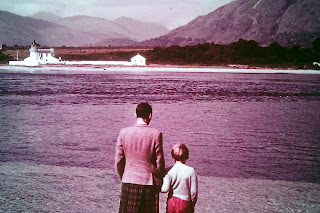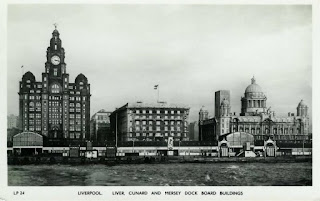Still - The remembrance of lost time
I was recently reminded of the creation of my final piece for my university dissertation. As it was a Creative Writing Masters Degree, I had opted to write a portfolio of 30 poems, but after many weeks of trial and error, I couldn't decide where to go with the project.
So, in order to get away from the pressure of not writing, I went to visit a good car boot at York Racecourse, its one of the best venues I have ever seen, with a great mix of genuine sellers and antique dealers.
After picking up a few diecasts, a couple of old camera lenses and the odd book, I was wrapping up my perusal when I came upon a stall which was obviously from a house clearance. There was the usual array of boxes of ornaments, books, kitchen equipment and old shoes - but on the floor in a plastic washing basket were several boxes of old photographic camera slides. Initially, I thought the boxes would be useful, but on closer inspection, I found they were glass positives, hand finished and labelled. I gathered them up, thinking they might make a nice curio for display, if the price was right. At 50p per box, it certainly was, so I collected up all I could find and bought them, shoving them into my Aldi carrier bag before moving on to the last few stalls.
 |
| Hand finished glass slides of European trips |
When I got back a few days later, I examined them more closely. There were three boxes, all labelled up, some appearing to be holiday snaps from a European trip and a lot more from a road trip to Scotland.
 |
| Castle Stalker - as featured in Monty Python and the Holy Grail |
 |
| Time & Tide |
The date on the slide was 1965 and the image so reminded me of a favourite shot of myself and my late father - from around the same period - on West Kirby beach in the Wirral, that I felt quite sad and quickly packed everything away.
It was some weeks later, during a writing session, that I hatched the idea of a series of ekphrastic poems - which describe or relate directly to an image - and began to write using the slides and their beautiful sweeping highland panoramas, as the basis. I had sorted through them, choosing some choice images of mountains and lochs and had taken the family grouping out of the set completely, as I found it difficult to look at them, without feeling upset in some vague way.
Over the next few months, the poetry began to materialise and I felt confident that I would be able to get something useable from them. Xmas rolled around and I received a joint gift of a holiday for myself and my wife, for a coach tour round the Western Highlands, out of Oban and I immediately thought that it would be the ideal time to get some supplementary photographs on the way and maybe do a little on the spot writing.
The following February, we took off on the weeks excursion and had a great time, enjoying the sights and sounds of Scotland. Then, on a trip to Fort William, we passed a loch and a little way ahead I saw a bridge we needed to cross to get to the town. I had a sudden rush of deja vu and realised I had seen this bridge before. Back at the hotel, I checked my notes and the digital copies of the slides and realised that the photographer had taken a picture of the same bridge, back in 1965 and what was more, other slides showed images from the same areas that we were visiting.
 |
| Original Slide form 1965 |
 |
| Quick snap out of the coach window of the same bridge 2017 |
I was very pleasantly surprised and double checked the map to see the locations of almost half the slides tallied with stops that we were visiting on the trip. This then cemented my belief that I was doing the right thing and that choosing the slides as the basis for the writing was the right move. Being at the same vantage points that the mysterious photographer had visited almost half a century ago made me feel a strange kinship with them and the nature of the poems changed radically, becoming more personal and powerful. The rest of the holiday was spent busily photographing almost every part of the trip, using my iphones built in geolocation to tag the photographs for future reference.
With this new direction, I revisited the group shots on the beach and examined them more carefully. There was a young boy of about 4 or 5, and a mother and father. The addressee on the film mailing box had been a lady and most of the photos showed the man and the boy on the slide, so I began to assume the photographer had probably been the lady on the beach.
 |
| The Sound of Mull |
It was a great holiday and I fell completely in love with the Western Highlands and Islands, crossing from Oban to Mull, I saw a rainbow hovering over the sound and a visit to the Tobermory Distillery on the island, was especially inspiring!
 |
| Wee Drams |
It was round about half way through the portfolio, that I realised I would need a name for the set and began to try out different titles. Somewhere along the way I came up with 'Light of Other Days' and while discussing the idea with a friend and creative writing tutor, he said the title sounded vaguely familiar and that I had best check to avoid any copyright issues. A quick Google revealed that it was in fact the title of a science fiction story, written by Bob Shaw and featured in the August 1966 edition of Analog magazine. Cue Amazon and I managed to get a copy to look at and read the story. (I've since realised that its also the title of an Arthur C Clarke manuscript too)
If I had not been amazed at the amount of synchronicity displayed by the project so far, things were about to get a whole lot spookier!
Shaw had named his story for a poem by Thomas Moore's "Oft, in the Stilly Night"; which is quoted within the story and ends with the lines:
Shaw had named his story for a poem by Thomas Moore's "Oft, in the Stilly Night"; which is quoted within the story and ends with the lines:
Thus, in the stilly night,
Ere slumber’s chain has bound me,
Sad memory brings the light
Of other days around me.
These lines, in themselves echoed the sombre tone that had developed in the poetry, since I had made the connection between my dad and the person in the photograph, but when I read the story, I began to see why Shaw had chosen them.
The story concerned the invention of a material called 'slow glass' which impedes the flow of photonic energy through its mass and has the effect of storing energy, but most importantly, of delaying the appearance of any visual phenomena which is seen through it. Shaw explored the material and its effects in a larger series of stories, entitled 'Other Days, other Eyes'.
This in itself was fascinating, but the protagonist, a poet - visits a remote loch in Scotland on holiday and finds a small cottage fitted with slow glass windows. The owner of the cottage had lost his wife and family in an accident near the loch and due to the nature of slow glass, was able to preserve the images of his lost family inside the cottage, before they were killed, as a virtual memory.
The story concerned the invention of a material called 'slow glass' which impedes the flow of photonic energy through its mass and has the effect of storing energy, but most importantly, of delaying the appearance of any visual phenomena which is seen through it. Shaw explored the material and its effects in a larger series of stories, entitled 'Other Days, other Eyes'.
This in itself was fascinating, but the protagonist, a poet - visits a remote loch in Scotland on holiday and finds a small cottage fitted with slow glass windows. The owner of the cottage had lost his wife and family in an accident near the loch and due to the nature of slow glass, was able to preserve the images of his lost family inside the cottage, before they were killed, as a virtual memory.
 |
| Slow Glass Imagined |
This idea resonated strongly with my thoughts on the glass slides and an idea I had about quantum entanglement - that at some point in time, the photographer was still standing on a shore in Scotland, or overlooking a loch, just as I was, fifty years later.
 |
| View over Loch Linnhe |
Eventually, the sequence neared its end and I conceived of a title - 'Still'. This reflected the idea of the 'still' image and also the theoretical permanence of the quantum state - imagining that the photographer was 'still' taking photos back in 1966, as I was doing the same in 2017. During the course of the research for the writing, I also stumbled across a film about a Liverpool family growing up in the sixties directed by Terence Davies.
The film, "Distant Voices, Still Lives" was an autobiographical account centred around the difficult relationship the director had with his father and opens with a funeral, to the strains of the 1927 dirge 'There's a Man Going Round Taking Names', beautifully rendered by spiritualist singer Jessye Norman.
However, this also resonated with my research into the mystery photographer and the fact that I still had no idea who my benefactor had been. With this in mind, I penned the penultimate poem which for me, gave the project a little closure. I named it 'Shadow Aspect' after the Jungian theory of the psychological 'twin' and the unconcious action of the inner mind.
The film, "Distant Voices, Still Lives" was an autobiographical account centred around the difficult relationship the director had with his father and opens with a funeral, to the strains of the 1927 dirge 'There's a Man Going Round Taking Names', beautifully rendered by spiritualist singer Jessye Norman.
However, this also resonated with my research into the mystery photographer and the fact that I still had no idea who my benefactor had been. With this in mind, I penned the penultimate poem which for me, gave the project a little closure. I named it 'Shadow Aspect' after the Jungian theory of the psychological 'twin' and the unconcious action of the inner mind.
SHADOW ASPECT
There’s a man going round
taking names.
He has yours
and though
I press him for it
he will not relent.
Silent and still
grey hands deep
in black pockets
resolute - implacable.
All I have is a view
to understand and see
as you look askance
back across decades.
I cannot divine your calling,
since he purloined
your identity
slipping your name
into his darkest book
where it lies
stricken though with lines.
As a result of finding the discarded slides, I now make a point of printing certain photographs to be framed, in order that the memories contained therin can live that little bit longer.





